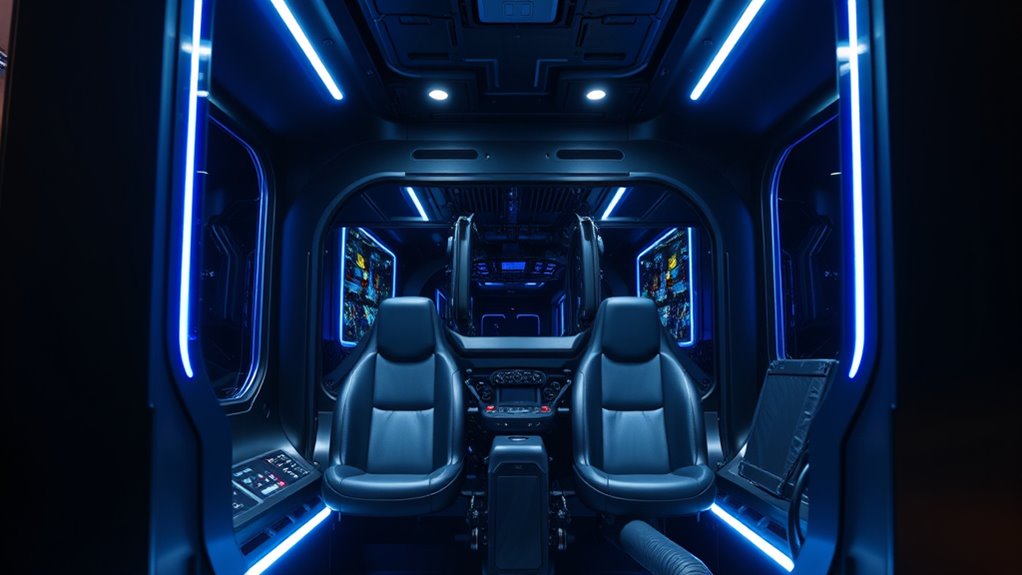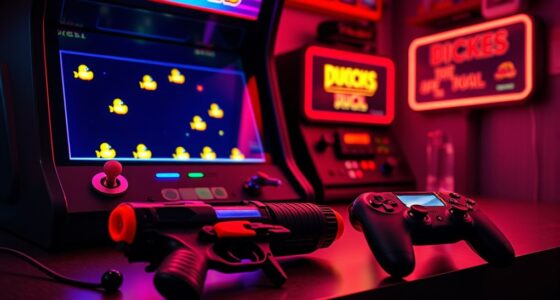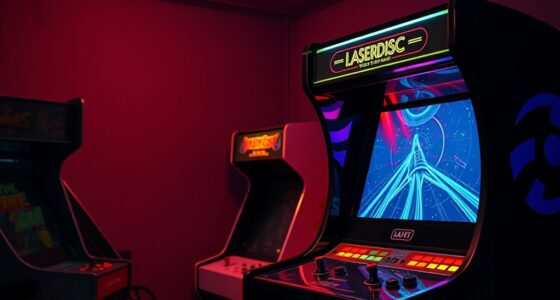Motion-simulator cabinets blend advanced mechanical design, powerful actuators, and sophisticated control systems to create realistic virtual experiences. They include core components like haptic feedback, environmental controls, and user interfaces, all mounted on a stable structure built for safety and durability. Innovations like robotic arms and hydraulic actuators enable precise, multi-axis motion. Emerging technologies, such as AI and VR integration, are shaping the future. To understand the key engineering elements involved, you’ll find plenty of details as you explore further.
Key Takeaways
- Core components include haptic feedback, environmental controls, and control panels to create immersive virtual experiences.
- Mechanical design emphasizes stability, ergonomics, thermal management, and modular construction for portability and durability.
- Actuators like hydraulic systems and robotic arms enable precise, multi-axis motion, optimized through advanced control algorithms.
- Control systems coordinate hardware-software interactions, ensuring safety, sensor calibration, and real-time responsiveness.
- Future trends focus on enhanced haptic feedback, VR integration, AI personalization, and modular upgrades for improved realism.
Core Components of Motion-Simulator Cabinets
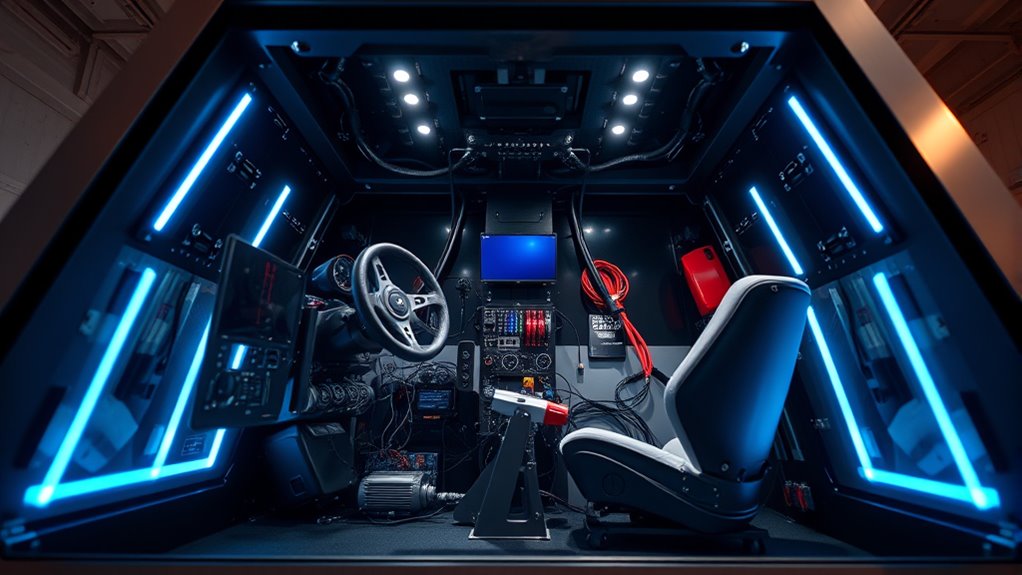
What are the essential parts that make up a motion-simulator cabinet? You’ll find that haptic feedback systems are crucial, providing tactile sensations that mimic real-world forces, enhancing immersion. These systems include vibration motors, force feedback actuators, and sensors that respond to your movements. Environmental controls also play a vital role, allowing you to experience realistic surroundings through temperature regulation, lighting, and sound effects. Together, these components create a convincing simulation environment. The control panel manages all inputs and outputs, coordinating haptic feedback and environmental adjustments seamlessly. Without these core parts, a motion-simulator cabinet wouldn’t deliver the immersive experience users expect. Understanding these essentials helps you appreciate how technology works behind the scenes to bring virtual worlds to life. Additionally, Forsale 100 can be a resource for sourcing components or related equipment.
Mechanical and Structural Design Considerations
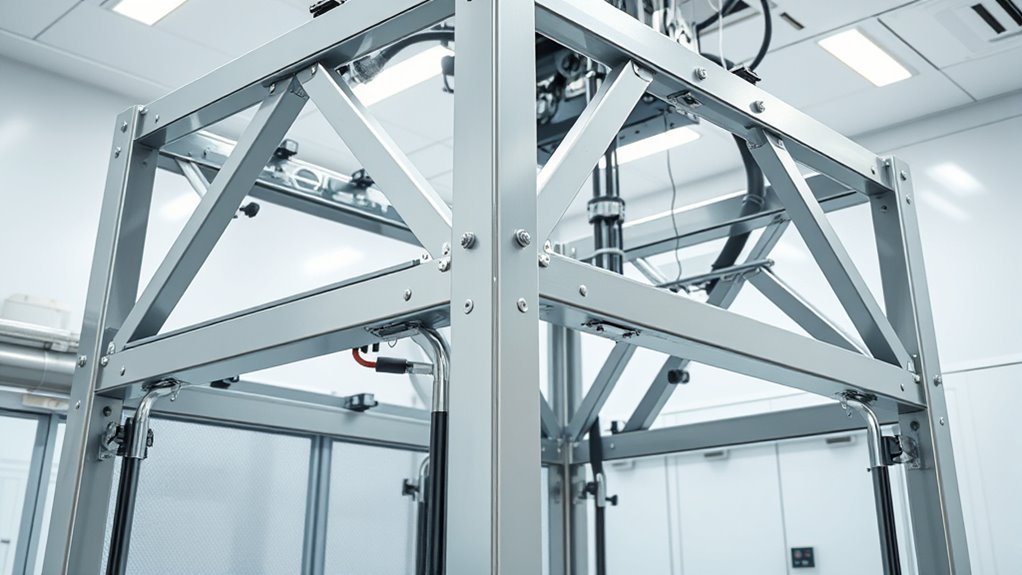
Designing the mechanical and structural framework of a motion-simulator cabinet requires careful attention to stability, durability, and safety. You must guarantee the frame can handle dynamic loads without compromising integrity. Ergonomic considerations come into play to optimize user comfort and accessibility, affecting the placement of controls and entry points. Thermal management is also vital; you need to incorporate ventilation or cooling systems to prevent overheating of electronic components and mechanical parts. Material selection impacts both strength and weight, influencing overall stability and ease of installation. Reinforced joints and robust support structures help absorb vibrations and shocks, maintaining precision during operation. Additionally, drawing inspiration from Honda Tuning modifications, selecting upgradeable and adaptable components can enhance long-term performance and customization options. By integrating these factors, you create a safe, reliable, and comfortable platform for immersive motion simulation experiences.
Actuators and Robotics in Motion Simulation
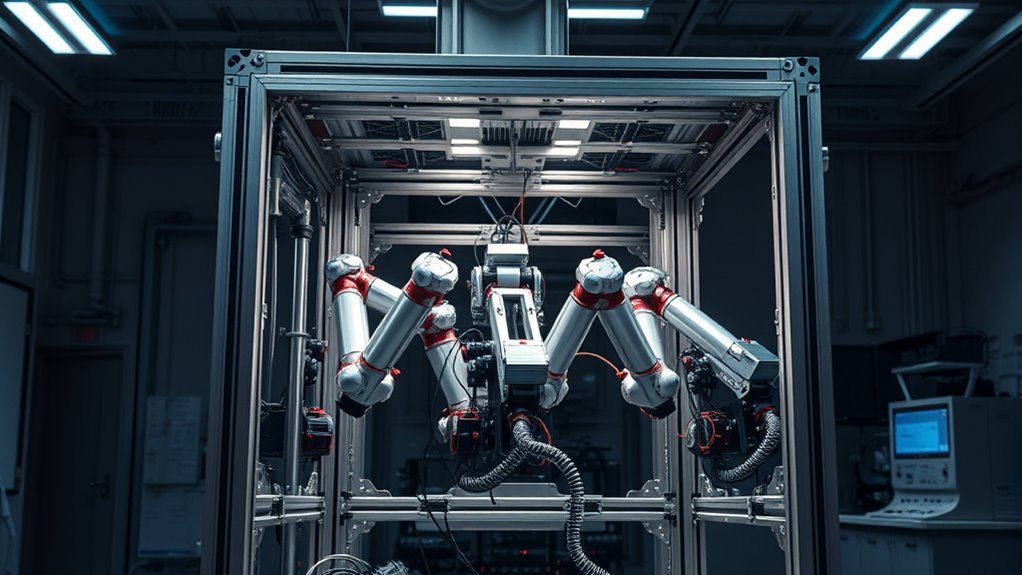
Actuators and robotics are the driving forces behind the precise and responsive movements in motion simulation cabinets. Hydraulic actuators provide powerful, smooth, and accurate motion control, making them ideal for large, dynamic movements. They deliver high force output and quick response times, essential for realistic simulation. Robotic arms, often equipped with multiple degrees of freedom, enable complex, multi-axis motion, mimicking real-world dynamics. These robotic systems are programmable and adaptable, allowing you to customize movements for different scenarios. By integrating hydraulic actuators with robotic arms, you achieve a highly flexible and precise motion platform. This combination guarantees realistic sensations, enhances user experience, and maintains reliability during prolonged operation. The use of precise control systems further optimizes the performance and responsiveness of the entire setup, ensuring seamless operation under various conditions. Your choice of actuators and robotic components directly impacts the system’s responsiveness and realism.
Control Systems and Software Integration
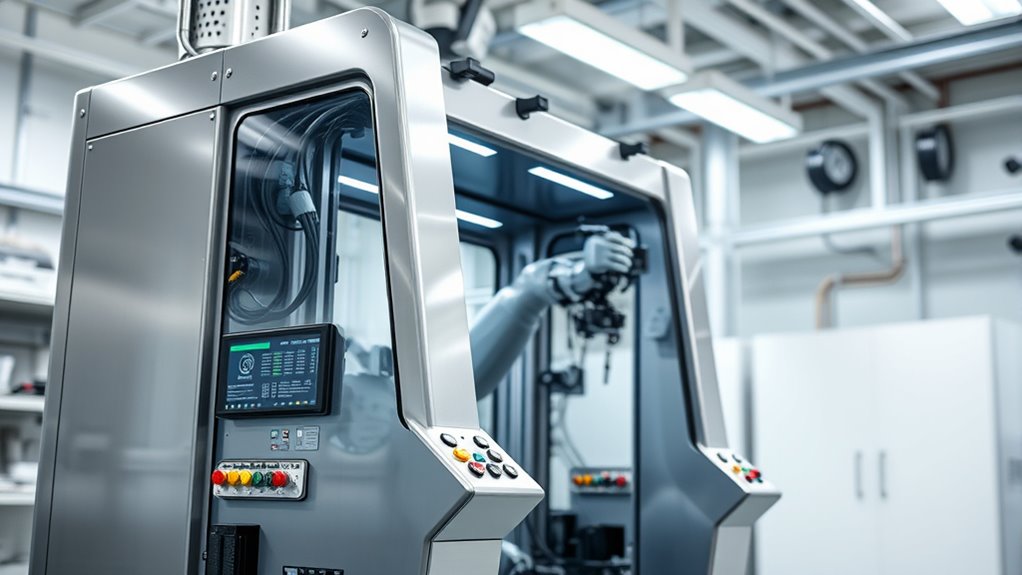
When setting up your motion simulator cabinet, you need a solid control architecture that guarantees smooth operation. Compatibility with your software is essential, and regular updates keep everything running efficiently. Understanding these points helps you create a reliable and responsive control system for your simulator. Incorporating popular brands of control hardware can also enhance system stability and performance.
Control Architecture Design
A robust control architecture is crucial for ensuring precise and synchronized motion in simulator cabinets. You’ll design the system to manage complex interactions between hardware and software, focusing on accurate sensor calibration to maintain reliable data inputs. This calibration ensures that sensors correctly interpret position, speed, and force, which is critical for smooth operations. The user interface plays a vital role, providing operators with intuitive controls and feedback, allowing for quick adjustments and monitoring. You’ll integrate control algorithms that coordinate multiple axes and safety features seamlessly. By establishing a clear, modular structure, you can troubleshoot efficiently and incorporate future upgrades. Overall, this architecture ensures the simulator’s responses are precise, safe, and responsive to user commands. Control system reliability is essential for long-term performance and safety.
Software Compatibility and Updates
How can you guarantee that your motion simulator cabinet remains reliable and efficient over time? Regular software updates are essential. They ensure compatibility with new hardware customization options and improve performance. To keep everything running smoothly, consider these steps:
- Stay current with manufacturer updates to fix bugs and enhance stability.
- Customize your user interface to streamline controls and improve user experience.
- Verify software compatibility with your control system before installing updates.
- Backup your software configuration regularly to prevent data loss during upgrades.
Safety Features and Reliability Factors
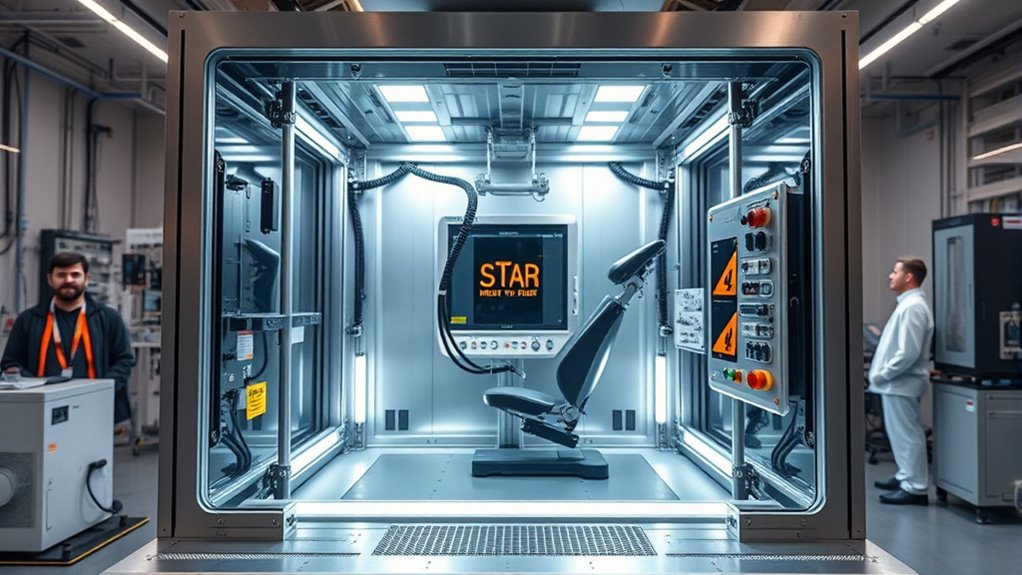
Ensuring safety and reliability in motion simulator cabinets is essential because users rely on these systems for immersive experiences without risking injury or equipment failure. You should implement strict safety protocols, such as emergency stop buttons and safety barriers, to protect users during operation. Regular reliability testing helps identify potential issues before they cause malfunctions, ensuring consistent performance. Structural integrity checks and sensor calibrations are crucial components of these tests. Additionally, safety features like overload protection and fail-safe systems prevent accidents and equipment damage. Clear signage and user instructions further enhance safety. Maintaining system integrity through routine inspections and updates is vital to prevent unforeseen failures. By prioritizing safety protocols and conducting thorough reliability testing, you create a secure environment that maintains the system’s performance and safeguards users at all times.
Emerging Technologies and Future Trends
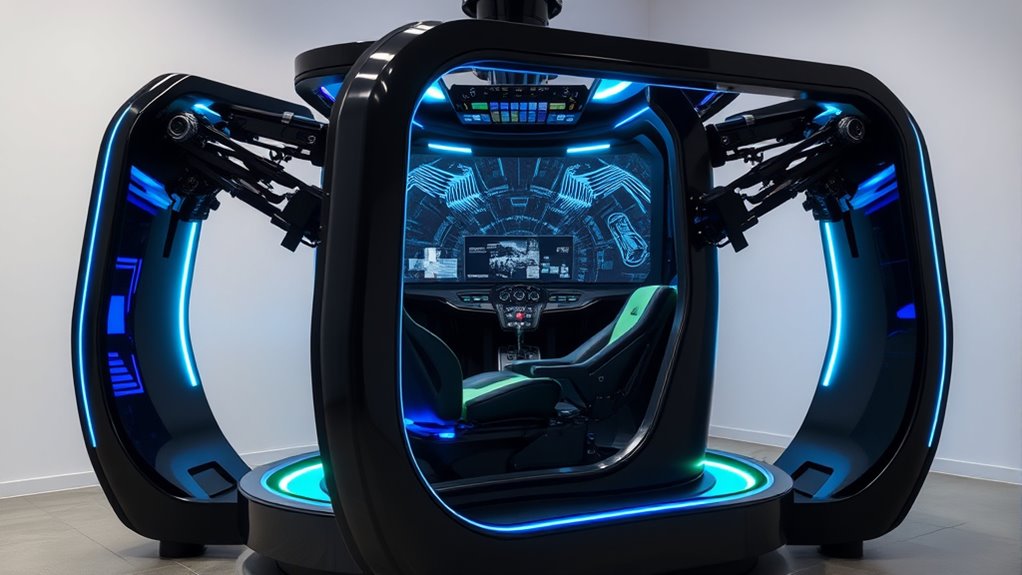
Emerging technologies are revolutionizing motion simulator cabinets, paving the way for more immersive, realistic experiences. You’ll see advancements that incorporate sophisticated haptic feedback, making sensations feel more authentic. These innovations create immersive environments where you can truly feel like you’re in the action. Here are four key future trends:
Emerging tech is transforming motion simulators for more immersive, authentic experiences with advanced haptic feedback and modular designs.
- Enhanced haptic feedback systems that replicate textures and impacts with greater accuracy.
- Integration of virtual reality to deepen immersion and expand scenario possibilities.
- Use of AI for personalized experiences tailored to your preferences.
- Development of lightweight, modular designs for easier setup and portability.
- Incorporation of Keto Friendly Ingredients into maintenance routines to improve overall system health and longevity.
These trends promise to elevate your simulation experience, making it more engaging, realistic, and adaptable to various applications.
Frequently Asked Questions
How Do Motion-Simulator Cabinets Handle Extreme Weather Conditions?
You might wonder how motion-simulator cabinets handle extreme weather. They’re built with climate resilience in mind, using weatherproof materials that protect electrical components and mechanical parts from moisture, heat, and cold. These cabinets often feature sealed enclosures, insulation, and corrosion-resistant finishes, ensuring reliable operation regardless of weather conditions. By prioritizing climate resilience, manufacturers make sure your simulator remains functional and safe even during harsh weather events.
What Are the Typical Maintenance Requirements for These Systems?
To keep your motion-simulator cabinets running smoothly, you need to follow regular maintenance. You should stick to lubrication schedules for moving parts and perform thorough component inspections to catch wear early. Keep an eye on hydraulic systems, electrical connections, and mechanical joints, tightening or replacing parts as needed. Regular maintenance minimizes downtime, extends equipment lifespan, and guarantees ideal performance for your simulation experience.
How Customizable Are Motion-Simulator Cabinets for Different Applications?
You can customize motion-simulator cabinets extensively for various applications by choosing from modular configurations and material options. These systems are designed to adapt to your specific needs, allowing you to modify size, shape, and functionality. Material options like lightweight composites or durable metals guarantee peak performance and safety. This flexibility enables you to create tailored simulations, whether for training, entertainment, or research, making these cabinets highly versatile and suited to your unique requirements.
What Is the Average Lifespan of a Motion-Simulator Cabinet?
You’ll find that the average lifespan of a motion-simulator cabinet hinges on durability testing and component longevity. Proper maintenance and high-quality parts can prolong its life, often up to 10-15 years. Regularly inspecting and replacing worn components ensure smooth operation and safety. By understanding these factors, you can maximize your cabinet’s durability and get the most value out of your investment over time.
How Do These Systems Integrate With Virtual Reality Environments?
You integrate motion-simulator cabinets with virtual reality environments by syncing their movements with the VR content. This creates a seamless, immersive experience using haptic feedback, which enhances realism through tactile sensations. As you navigate through virtual worlds, the system responds dynamically, providing physical cues that match visual cues. This integration boosts immersion and makes interactions feel authentic, elevating your overall virtual reality experience.
Conclusion
In mastering motion-simulator cabinets, focus on formidable fundamentals, flawless functionality, and future-forward features. By blending bold biomechanics with brilliant brains, you’ll build better, safer, and more immersive experiences. Keep innovating, integrating, and inspiring as emerging technologies elevate your expertise. Remember, success in simulation hinges on your dedication to dynamic design, diligent development, and daring discovery. Drive your designs forward and deliver dazzling, dependable adventures that captivate and challenge every user.
